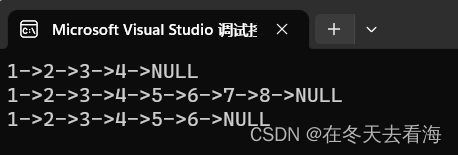
单链表
1 链表的概念及结构
概念:链表是一种物理存储结构上非连续、非顺序的存储结构,数据元素的逻辑顺序是通过链表中的指针链
接次序实现的 。
在我们开始讲链表之前,我们是写了顺序表,顺序表就是类似一个数组的东西,它的存放是连续的,优点有很多,比如支持我们随机访问,连续存放,命中率高,区别于单链表我们可以用类似数组的下标进行访问,这大大的提高我们的效率,但是也有缺点,空间不够就要需要扩容,扩容存在消耗的,头部或者中间位置的插入删除,需要挪动,挪动数据也是存在消耗的。避免频繁扩容,一次一般都是按倍数扩容,可能存在空间扩容。
链表的优点:
按需申请空间,不用释放空间。
头部或者中间位置的插入和删除,不需要挪动数据。
不存在空间浪费。
链表的缺陷:
每一个数据,都要存放一个指针去链表后面节点的地址。
不支持随机访问。
链表的结构
typedef int SLNodedataType;
typedef struct SList
{SLNodedataType data;struct SList* next;}SLNode;
这个就是我们单链表的基本代码,我们来用图更加清清楚的表示一下它完整的样子。

这就我们基本的逻辑结构,它前一个的next是存放后面的地址的,这样就能找到我们下一个节点。
单链表使用的时候相比和顺序表比较的话,它的使用不会浪费空间,我们需要一个节点就可以开辟一个节点出来供我们使用。但是它存储就不是连续的了。
那我们现在开始写代码来实现单链表。
单链表
首先我们要创建一个结构体。
typedef int SLNodedataType;
typedef struct SList
{SLNodedataType data;struct SList* next;}SLNode;
接下来我们首先要打印我们的单链表
在这之前我们应该创建节点,创捷节点很简单,就是按照我们上面的图的前一个存放后面的地址。
//创建节点SLNode* n1 = (SLNode*)malloc(sizeof(SLNode));assert(n1);SLNode* n2 = (SLNode*)malloc(sizeof(SLNode));assert(n2);SLNode* n3 = (SLNode*)malloc(sizeof(SLNode));assert(n3);SLNode* n4 = (SLNode*)malloc(sizeof(SLNode));assert(n4);n1->data = 1;n2->data = 2;n3->data = 3;n4->data = 4;n1->next = n2;n2->next = n3;n3->next = n4;n4->next = NULL;
那下面就是我们的打印单链表。
void SListPrint(SLNode* plist)
{SLNode* cur = plist;while (cur != NULL){printf("%d->", cur->data);cur = cur->next;}printf("NULL");printf("\n");}
我们来测试一下看看效果。

可以看到我们的单链表也是成功的打印,那接下来就是要写出我们的尾插函数。
写之前我们先来分析分析,首先尾插一个节点进去,那我们是不是要有一个这样的节点,竟然这样就可以写一个创造节点的函数。就叫他CreateSListNode
SLNode* CreateSListNode(SLNodedataType x)
{SLNode* newnode = (SLNode*)malloc(sizeof(SLNode));newnode->data = x;newnode->next = NULL;return newnode;
}
写完这个那我们写一个尾插函数,尾插的时候我们要想一想要传什么地址过去,如果是有数据的话其实我们传一级地址就行,但是如果是空的话,就得传二级,因为我们要改变plist的位置。但是也其实是相当于头插,没节点的时候,总不能在空指针后面插入。那我们写一个 吧。
void SListPushBcak(SLNode** plist, SLNodedataType x)
{SLNode*newnode=CreateSListNode(x);assert(plist);if (*plist == NULL){plist = newnode;}else{SLNode* tail = *plist;while (tail->next != NULL){tail = tail->next;}tail->next = newnode;}}
看一下我们编译的结果

最后也是成功的尾插进去,那尾插之后就应该要写一个尾删。
写尾删的时候,我们要先考虑怎么找到最后,这和尾插一样,遍历一遍找到最后一个,然后free掉就行了。

代码
void SListPopBack(SLNode** plist)
{SLNode* tail = *plist;SLNode* prev = NULL;while (tail->next != NULL){prev = tail;tail = tail->next;}free(tail);prev->next = NULL;
}
这其实就是用了一个双指针的方法找最后一个的前一个,但是我们还需要注意链表不能为空,空了怎么删除啊。所以改进一下。
void SListPopBack(SLNode** plist)
{assert(plist);assert(*plist);SLNode* tail = *plist;SLNode* prev = NULL;while (tail->next != NULL){prev = tail;tail = tail->next;}free(tail);prev->next = NULL;
}
void test1()
{//创建节点SLNode* n1 = (SLNode*)malloc(sizeof(SLNode));assert(n1);SLNode* n2 = (SLNode*)malloc(sizeof(SLNode));assert(n2);SLNode* n3 = (SLNode*)malloc(sizeof(SLNode));assert(n3);SLNode* n4 = (SLNode*)malloc(sizeof(SLNode));assert(n4);n1->data = 1;n2->data = 2;n3->data = 3;n4->data = 4;n1->next = n2;n2->next = n3;n3->next = n4;n4->next = NULL;SListPrint(n1);SListPushBcak(&n1, 5);SListPushBcak(&n1, 6);SListPushBcak(&n1, 7);SListPushBcak(&n1, 8);SListPrint(n1);SListPopBack(&n1);SListPopBack(&n1);SListPrint(n1);
}
不过其实我们也可以不用双指针的办法。
那也整一个玩玩吧
void SListPopBack(SLNode** plist)
{assert(plist);assert(*plist);SLNode* tail = *plist;while (tail->next->next != NULL){tail = tail->next;}free(tail->next);tail->next = NULL;其实道理是一样的,就是找下下一个的节点是不是为空。
尾插写好就是头插,来吧展示。
void SListPushFront(SLNode** plist, SLNodedataType x)
{assert(plist);SLNode* newnode = CreateSListNode(x);if (*plist == NULL){*plist = newnode;}else{newnode->next = *plist;*plist = newnode;}}
其实想明白也不难,接下来就是头删。
void test1()
{//创建节点SLNode* n1 = (SLNode*)malloc(sizeof(SLNode));assert(n1);SLNode* n2 = (SLNode*)malloc(sizeof(SLNode));assert(n2);SLNode* n3 = (SLNode*)malloc(sizeof(SLNode));assert(n3);SLNode* n4 = (SLNode*)malloc(sizeof(SLNode));assert(n4);n1->data = 1;n2->data = 2;n3->data = 3;n4->data = 4;n1->next = n2;n2->next = n3;n3->next = n4;n4->next = NULL;SListPrint(n1);SListPushBcak(&n1, 5);SListPushBcak(&n1, 6);SListPushBcak(&n1, 7);SListPushBcak(&n1, 8);SListPrint(n1);SListPopBack(&n1);SListPopBack(&n1);SListPrint(n1);SListPushFront(&n1, 111);SListPushFront(&n1, 222);SListPrint(n1);SListPopFront(&n1);SListPopFront(&n1);SListPopFront(&n1);SListPrint(n1);}
void SListPopFront(SLNode** plist)
{assert(plist);assert(*plist);SLNode* cur = (*plist)->next;free(*plist);*plist = cur;
}
我们在写一个查找功能的代码
SLNode* SLFind(SLNode* plist, SLNodedataType x);
查找我们可以返回这个节点,这样就能和其他功能一起用,比如修改数据,或者在任意位置插入和删除。
SLNode* SLFind(SLNode* plist, SLNodedataType x)
{SLNode* pos = plist;while (pos->data == x){return pos;pos = pos->next;}
}
这是只考虑找到的情况下,但是难免有时候会出现找不到的情况,让我们来看一下吧,写一个找不到情况下和找到情况下的代码。‘
SLNode* SLFind(SLNode* plist, SLNodedataType x)
{SLNode* pos = plist;while (pos != NULL){if (pos->data == x){return pos;}pos = pos->next;}return NULL;
}
然后我们可以写一个函数来判断有没有找到。
SLNode*pos = SLFind(n1, 111);if (pos != NULL){printf("找到了\n");}else{printf("找不到\n");}我们看完整代码。
void test1()
{//创建节点SLNode* n1 = (SLNode*)malloc(sizeof(SLNode));assert(n1);SLNode* n2 = (SLNode*)malloc(sizeof(SLNode));assert(n2);SLNode* n3 = (SLNode*)malloc(sizeof(SLNode));assert(n3);SLNode* n4 = (SLNode*)malloc(sizeof(SLNode));assert(n4);n1->data = 1;n2->data = 2;n3->data = 3;n4->data = 4;n1->next = n2;n2->next = n3;n3->next = n4;n4->next = NULL;SListPrint(n1);SListPushBcak(&n1, 5);SListPushBcak(&n1, 6);SListPushBcak(&n1, 7);SListPushBcak(&n1, 8);SListPrint(n1);SListPopBack(&n1);SListPopBack(&n1);SListPrint(n1);SListPushFront(&n1, 111);SListPushFront(&n1, 222);SListPrint(n1);SListPopFront(&n1);SListPopFront(&n1);SListPopFront(&n1);SListPrint(n1);SLNode*pos = SLFind(n1, 111);if (pos != NULL){printf("找到了\n");}else{printf("找不到\n");}}
我们如果要找111发现没有找到,因为头删的时候改掉,其实我们竟然这样写了就可以写一个修改的代码,这里就不演示了。
接下来我们要写的是在任意位置删除和插入节点。
void SListPushInsert(SLNode** plist, SLNode* pos, SLNodedataType x)
{assert(plist);assert(pos);SLNode* newnode = CreateSListNode(x);if (pos == *plist){SListPushFront(plist, x);}else{SLNode* prev = *plist;while (prev->next != pos){prev = prev->next;}prev->next = newnode;newnode->next = pos;}
}
测试代码
void test1()
{//创建节点SLNode* n1 = (SLNode*)malloc(sizeof(SLNode));assert(n1);SLNode* n2 = (SLNode*)malloc(sizeof(SLNode));assert(n2);SLNode* n3 = (SLNode*)malloc(sizeof(SLNode));assert(n3);SLNode* n4 = (SLNode*)malloc(sizeof(SLNode));assert(n4);n1->data = 1;n2->data = 2;n3->data = 3;n4->data = 4;n1->next = n2;n2->next = n3;n3->next = n4;n4->next = NULL;SListPrint(n1);SListPushBcak(&n1, 5);SListPushBcak(&n1, 6);SListPushBcak(&n1, 7);SListPushBcak(&n1, 8);SListPrint(n1);SListPopBack(&n1);SListPopBack(&n1);SListPrint(n1);SListPushFront(&n1, 111);SListPushFront(&n1, 222);SListPrint(n1);SListPopFront(&n1);SListPopFront(&n1);SListPopFront(&n1);SListPrint(n1);SLNode*pos = SLFind(n1,3);if (pos != NULL){printf("找到了\n");SListPushInsert(&n1, pos, 10086);}else{printf("找不到\n");}SListPrint(n1);
}
在任意位置删除
void SListPopInsert(SLNode** plist, SLNode* pos)
{assert(plist);assert(*plist);assert(pos);if (*plist == pos){SListPopFront(plist);}else{SLNode* prev = *plist;while (prev->next != pos){prev = prev->next;}prev->next = pos->next;free(pos);}
}
其实还有可以在任意位置后删除,这样更快,就不用找那个位置前一个位置了,这里就不展示了,
完整代码
#define _CRT_SECURE_NO_WARNINGS 1#include<stdio.h>
#include<assert.h>
#include<stdlib.h>typedef int SLNodedataType;
typedef struct SList
{SLNodedataType data;struct SList* next;}SLNode;void SListPrint(SLNode* plist);SLNode* CreateSListNode(SLNodedataType x);void SListPushBcak(SLNode** plist, SLNodedataType x);void SListPopBack(SLNode** plist);void SListPushFront(SLNode** plist, SLNodedataType x);void SListPopFront(SLNode** plist);SLNode* SLFind(SLNode* plist, SLNodedataType x);void SListPushInsert(SLNode** plist, SLNode* pos, SLNodedataType x);void SListPopInsert(SLNode** plist, SLNode* pos);#include"SList.h"void SListPrint(SLNode* plist)
{SLNode* cur = plist;while (cur != NULL){printf("%d->", cur->data);cur = cur->next;}printf("NULL");printf("\n");}SLNode* CreateSListNode(SLNodedataType x)
{SLNode* newnode = (SLNode*)malloc(sizeof(SLNode));newnode->data = x;newnode->next = NULL;return newnode;
}void SListPushBcak(SLNode** plist, SLNodedataType x)
{SLNode*newnode=CreateSListNode(x);assert(plist);if (*plist == NULL){plist = newnode;}else{SLNode* tail = *plist;while (tail->next != NULL){tail = tail->next;}tail->next = newnode;}}void SListPopBack(SLNode** plist)
{assert(plist);assert(*plist);SLNode* tail = *plist;SLNode* prev = NULL;while (tail->next != NULL){prev = tail;tail = tail->next;}free(tail);prev->next = NULL;
}
//
//void SListPopBack(SLNode** plist)
//{
// assert(plist);
// assert(*plist);
// SLNode* tail = *plist;
//
// while (tail->next->next != NULL)
// {
//
// tail = tail->next;
// }
// free(tail->next);
// tail->next = NULL;
//
//}void SListPushFront(SLNode** plist, SLNodedataType x)
{assert(plist);SLNode* newnode = CreateSListNode(x);if (*plist == NULL){*plist = newnode;}else{newnode->next = *plist;*plist = newnode;}}void SListPopFront(SLNode** plist)
{assert(plist);assert(*plist);SLNode* cur = (*plist)->next;free(*plist);*plist = cur;
}//SLNode* SLFind(SLNode* plist, SLNodedataType x)
//{
// SLNode* pos = plist;
// while (pos->data == x)
// {
// return pos;
// pos = pos->next;
// }
//}SLNode* SLFind(SLNode* plist, SLNodedataType x)
{SLNode* pos = plist;while (pos != NULL){if (pos->data == x){return pos;}pos = pos->next;}return NULL;
}void SListPushInsert(SLNode** plist, SLNode* pos, SLNodedataType x)
{assert(plist);assert(pos);SLNode* newnode = CreateSListNode(x);if (pos == *plist){SListPushFront(plist, x);}else{SLNode* prev = *plist;while (prev->next != pos){prev = prev->next;}prev->next = newnode;newnode->next = pos;}
}void SListPopInsert(SLNode** plist, SLNode* pos)
{assert(plist);assert(*plist);assert(pos);if (*plist == pos){SListPopFront(plist);}else{SLNode* prev = *plist;while (prev->next != pos){prev = prev->next;}prev->next = pos->next;free(pos);}
}
测试主函数的也发一下吧,大家可以不用放一起测试,有点看不过来。
#include"SList.h"void test1()
{//创建节点SLNode* n1 = (SLNode*)malloc(sizeof(SLNode));assert(n1);SLNode* n2 = (SLNode*)malloc(sizeof(SLNode));assert(n2);SLNode* n3 = (SLNode*)malloc(sizeof(SLNode));assert(n3);SLNode* n4 = (SLNode*)malloc(sizeof(SLNode));assert(n4);n1->data = 1;n2->data = 2;n3->data = 3;n4->data = 4;n1->next = n2;n2->next = n3;n3->next = n4;n4->next = NULL;SListPrint(n1);SListPushBcak(&n1, 5);SListPushBcak(&n1, 6);SListPushBcak(&n1, 7);SListPushBcak(&n1, 8);SListPrint(n1);SListPopBack(&n1);SListPopBack(&n1);SListPrint(n1);SListPushFront(&n1, 111);SListPushFront(&n1, 222);SListPrint(n1);SListPopFront(&n1);SListPopFront(&n1);SListPopFront(&n1);SListPrint(n1);SLNode*pos = SLFind(n1,3);if (pos != NULL){printf("找到了\n");SListPushInsert(&n1, pos, 10086);}else{printf("找不到\n");}SListPrint(n1);
}
int main()
{test1();return 0;
}
今天的分享就到这里,我们下次再见。


_kaic)



k8s及kuboard V3)





《正则表达式-grep工具》)

按键扫描与定时器中断)
 CCodec Native服务实现分析)
微分中值定理和导数的应用)


